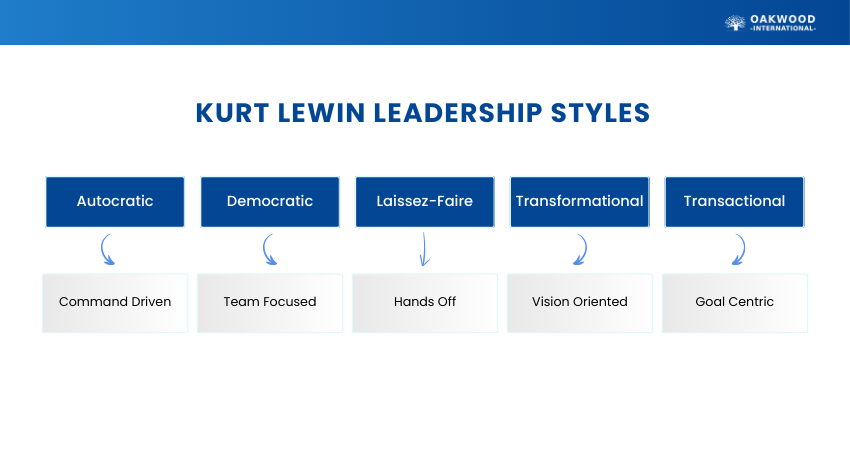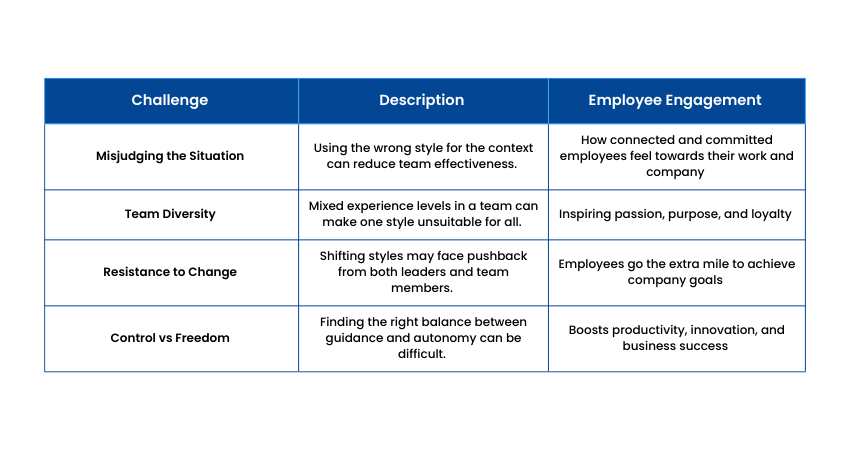Table of Contents


What do your leadership choices say about you? Are you the boss who takes charge, the leader who gathers input, or the relaxed one who lets the team run free? This is where Kurt Lewin’s Leadership Styles comes in, offering a mirror to your methods. It is time to see yourself clearly. In this blog, we’ll unpack each style, strengths and weaknesses and help you discover which leadership approach fits you best. So, let’s find out which style suits your stride!
Table of Contents
1) What are the Three Leadership Styles by Kurt Lewin?
2) Strengths of Kurt Lewin’s Leadership Styles
3) Common Challenges in Applying Kurt Lewin’s Leadership Style
4) Best Practices for Implementing Lewin’s Leadership Approaches
5) Additional Leadership Styles and Models
6) Conclusion
What are the Three Leadership Styles by Kurt Lewin?
Kurt Lewin, a German-American psychologist, introduced his Leadership Theory in the 1930s, making it one of the earliest frameworks for understanding leadership behaviour. He identified three distinct styles of leadership that influence how leaders interact with their teams and make decisions. These are widely known as Kurt Lewin Leadership Styles.

1) Autocratic Leadership Style
The autocratic style is highly directive, with the leader maintaining strict control over decisions and processes. Team members have little input, and the leader’s instructions are expected to be followed precisely.
Example: A chef in a busy kitchen barks out orders - “Do this, do that!” No questions, just action.
Key Characteristics
a) Leader makes decisions without consulting the team
b) Clear rules, guidelines, and expectations are set
c) Strict authority and control are maintained
d) Communication flows top-down
Advantages
a) Useful in emergencies requiring quick decisions
b) tasks are completed efficiently
c) Provides structure in chaotic or high-risk environments
Disadvantages
a) Can lower employee morale and motivation
b) Suppresses creativity and innovation
c) May lead to resentment or disengagement over time
2) Democratic Leadership Style
The democratic style encourages participation, collaboration, and open communication. Leaders seek input before making decisions and value the contributions of all team members. His approach is one of the most balanced in the Kurt Lewin Leadership Styles framework.
Example: A film director discusses scene ideas with the crew, asking for opinions before deciding.
Key Characteristics
a) Decisions are made with team involvement
b) Open discussions and idea-sharing are encouraged
c) Leaders act as facilitators rather than controllers
d) Strong emphasis on feedback and collaboration
Advantages
a) Builds trust, engagement, and motivation
b) Improves creativity and problem-solving
c) Creates stronger team ownership of outcomes
Disadvantages
a) Decision-making can be time-consuming
b) Risk of conflict when opinions differ
c) May slow progress in urgent situations
3) Laissez-Faire Leadership Style
The laissez-faire style takes a hands-off approach, giving employees freedom to manage their own work. Leaders provide resources and support but avoid interfering in daily decisions. It is often considered the most relaxed of the Kurt Lewin Leadership Styles.
Example: A group of designers works independently while the lead says, “Call me if you need anything.”
Key Characteristics
a) Minimal guidance and supervision from leaders
b) Employees have independence in decision-making
c) Works best with skilled, motivated, and self-driven teams
d) Leader intervenes only when necessary
Advantages
a) Encourages innovation and creativity
b) Builds employee confidence and ownership
c) Suitable for expert teams who need flexibility
Disadvantages
a) Can cause confusion without clear direction
b) Risk of low productivity and accountability
c) May fail with inexperienced or unmotivated teams
Empower your leadership journey with practical, recognised skills – Start with ILM Level 4 Award in Leadership and Management today!
Strengths of Kurt Lewin’s Leadership Styles
Kurt Lewin's Leadership Styles is praised for its clarity, simplicity, and practical relevance. It outlines three distinct approaches: autocratic, democratic, and laissez-faire. These help leaders understand how their behaviour can influence team performance.
1) Simple and Practical Framework: Offers a clear, easy-to-understand structure that helps leaders identify and adopt different leadership approaches based on situational needs.
2) Adaptability Across Contexts: The model is versatile and can be applied to various industries, team sizes, and work environments, from fast-paced settings to creative projects.
3) Encourages Self-Awareness: Helps leaders reflect on their default Leadership Style and consider how their behaviour affects team morale, performance, and decision-making.
4) Promotes Situational Flexibility: Supports the idea that no single Leadership Style fits all situations, and leaders are encouraged to adjust their approach as circumstances change.
5) Useful for Training and Development: Frequently used in leadership training due to its foundational nature and ability to illustrate the impact of different leadership behaviours.
6) Enhances Team Outcomes When Applied Well: When the right style is used in the right context, it can improve productivity, foster trust, and build a positive team culture.
Lead boldly, think strategically - Your leadership upgrade starts here with the ILM Level 4 Diploma in Leadership and Management from now!
Common Challenges in Applying Kurt Lewin’s Leadership Style
Lewin’s leadership model provides useful guidance, but applying it in real-world situations comes with practical hurdles. Leaders often face difficulty selecting the right style, adapting to team dynamics, or managing transitions effectively.
Leaders often encounter practical hurdles that the model doesn’t fully address. These may include misjudging which style best fits the situation, struggling with diverse team dynamics, or facing resistance when attempting to shift from one approach to another. Below are some of the most common challenges leaders face when applying Lewin’s Leadership Styles:

Best Practices for Implementing Lewin’s Leadership Approaches
To use Lewin's styles effectively, leaders should adopt the following strategies:
1) Assess the Context: Match the leadership style to the situation. Urgent issues may require Autocratic methods, while long-term projects may benefit from democratic input.
2) Know Your Team: Understand their experience, confidence, and working preferences to apply the most effective style.
3) Be Flexible: Don’t rely solely on one style; great leaders adapt based on changing needs and team feedback.
4) Set Clear Expectations: Especially when using Laissez-Faire, establish goals, timelines, and accountability upfront.
5) Encourage Open Communication: Regardless of style, foster an environment where feedback and dialogue are welcomed.
Additional Leadership Styles and Models
Additional Leadership Styles and Models refer to a range of approaches leaders use based on context, team dynamics, and goals. These include modern, adaptive styles that go beyond traditional methods to enhance leadership effectiveness. Let's discuss the most important ones with illustration:
Transformational Leadership Style
Transformational Leadership is a style where leaders inspire, motivate, and elevate their team members to achieve more than they thought possible. These leaders lead by vision, personal influence, and a strong sense of purpose, often focusing on innovation, change, and individual growth.

Imagine a high school principal who sees potential in a struggling school. Instead of sticking to rigid policies, she rallies teachers around a new, student-centred approach, motivates staff with a compelling vision of success, introduces creative teaching methods, and celebrates small wins along the way. Morale improves, students engage more, and academic results start climbing, not just because of systems, but because the leader changed the culture.
In Transformational Leadership, the leader’s role goes beyond day-to-day goals to ignite passion and commitment in others. They are often found in organisations undergoing change or seeking to innovate.
Transactional Leadership Style
Transactional Leadership is a more traditional style based on a system of clear roles, structured tasks, and reward-punishment mechanisms. Leaders give instructions, expect compliance, and reward or discipline based on performance outcomes.

Think of a factory supervisor overseeing a production line. She sets daily targets and expects workers to meet them. If targets are met, employees get overtime pay or bonuses. If not, they’re coached or warned. There is no grand vision, just clear expectations, measurable results, and direct feedback.
This style is highly effective in stable environments where efficiency and routine are key. It focuses on short-term goals, consistency, and accountability. The relationship between leader and follower is often contractual.
Conclusion
Kurt Lewin’s Leadership Styles help leaders understand how different approaches impact team performance and morale. By recognising when to direct, collaborate, or step back, leaders can adapt more effectively to various situations. Choosing the right style depends on the team, task, and context and their plan for building confidence and flexible leadership.
Step beyond supervision with our ILM Level 4 Training - Learn to lead with impact!


 Back
Back



 Back to Catagories
Back to Catagories





 + 44 7452 122728
+ 44 7452 122728










